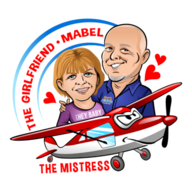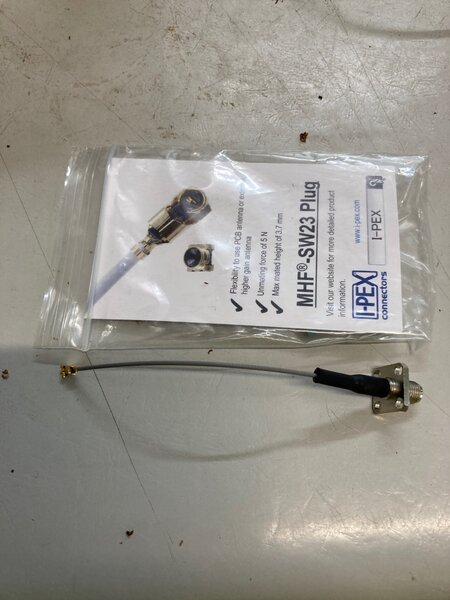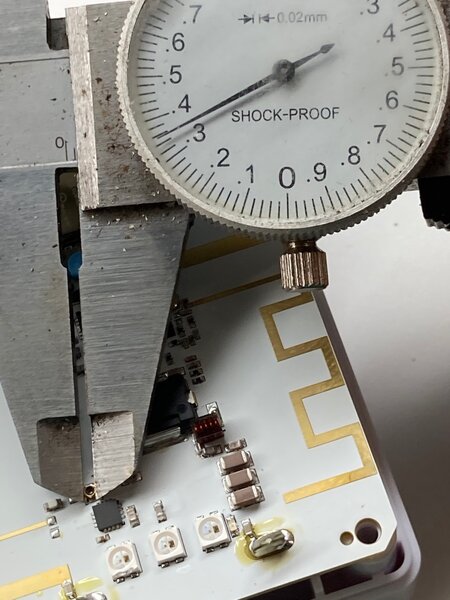-
Posts
6,674 -
Joined
-
Last visited
-
Days Won
101
Content Type
Profiles
Forums
Gallery
Downloads
Blogs
Events
Store
Aircraft
Resources
Tutorials
Articles
Classifieds
Movies
Books
Community Map
Quizzes
Videos Directory
Everything posted by Kyle Communications
-

My Savannah S model rebuild Blog
Kyle Communications replied to Kyle Communications's topic in Savannah
Hi Paul Not a lot lately worse luck. Just getting back to it now. Had some skin cancers cut off my left leg. 5 in all. 4 required skin grafts and one was just sliced out and stitched. The others were above the shin bone and went down almost to the bone. I had to stay in bed with my leg up for several weeks but the bottom 2..the largest 2 got infected..thats a story by itself but wont go into that. At one stage I thought I was going to lose my lower leg about 6 inchs up from the foot. Ended up back in hospital for 5 days and then many many weeks on the bed with my leg up on pillows. Anyone who knows me knows I have to be busy and it was killing me especially as I couldnt get on my leg. The upshot is 15 weeks later my leg is finally good enough to be able to stand on regularly now. Its still not fully healed and big holes still in it but progress has been slow but now at a point where this weekend I am back doing some work on it now. i could post some pics here but dont want to gross anyone out 😱 I am getting the spray booth organised this weekend and once erected I have to make a exhaust system for it. Then I can start to paint Mabel and once that done she will go down to the hangar for assembly. The engine is away at the moment getting a big bore kit fitted. New Eprop has arrived for it and the RANS as well. I am also putting in another large storage rack to crib more space as I have 2 aircraft in this shed of mine and its getting crowded with such large parts in here. Worked on getting the twin stick assembly mostly together last night. Almost finished the new throttle mod for both the Rotax engines I have here and finalized the CNC parts for the production versions of the throttle mods and they will be ordered and should be here in about 10 days time. So have to start to get at least 25 or more of those ready to go out. Had to make another quick batch of my replacement CDI modules and have another big batch on the go now. So this past 2 weeks or so has started to get me back into the swing of my usual daily plans. My other leg needs some work done on it with the skin cancers but am holding off on that again and looking at some other methods. The ones on my right leg are no where near as severe as the left leg so thats a blessing and maybe able to do it with Efudex or something like that So expect some more posts soon here Mark -

Lowering Class E between Melbourne and Cairns
Kyle Communications replied to Bosi72's topic in AUS/NZ General Discussion
Well of course you need enough clearance under the aircraft..the VHF and UHF on mine were about 300 back from the firwall on the floor...plenty of clearance -

Lowering Class E between Melbourne and Cairns
Kyle Communications replied to Bosi72's topic in AUS/NZ General Discussion
The ADSB will come up on your Ipad overlayed on what ever program you use ....if you use one Jack -

Lowering Class E between Melbourne and Cairns
Kyle Communications replied to Bosi72's topic in AUS/NZ General Discussion
Most put their transponder antenna under the aircraft...where in my opinion all antennas should be for aircraft at 10,000 ft or below anyway...but being so small the TR antenna can go dead centre of any large flat area which should even out the pattern a bit more. My VHF was under the nose of the sav and so was my UHF...you dont want to talk to the jet jocks at FL30 you talk to us plebs below FL10 -

Lowering Class E between Melbourne and Cairns
Kyle Communications replied to Bosi72's topic in AUS/NZ General Discussion
I think the SE2 is a fantastic value for money for what it does...as I said to be even far better than it is now a extenal antenna connection would improve it out of sight -

Lowering Class E between Melbourne and Cairns
Kyle Communications replied to Bosi72's topic in AUS/NZ General Discussion
The SE2 lets Airservices know where you are and what height and speed...realistically thats all they care about TCAS is only aircraft to aircraft so as far as they are concered its up to the pilots in that mode -

Lowering Class E between Melbourne and Cairns
Kyle Communications replied to Bosi72's topic in AUS/NZ General Discussion
Airservices and CASA know exactly how many are out...its pretty much no good if you dont get your hex code from CASA of course. So you are "on the system" and id'd. Even when running a EC device you realistically will pop up on the air services system but more likely you will come up on FlightAware and FR24..this data is pushed to most of the EFB anyway. Its a far better system than mode A or C -

Lowering Class E between Melbourne and Cairns
Kyle Communications replied to Bosi72's topic in AUS/NZ General Discussion
The SE2 needs to have a external antenna connection..this will greatly increase your see and be seen position. The GPS can still be inside the SE2 and mounted in the cockpit as it will get well enough GPS signal. 20watts into a external antenna mounted on the outside of the aircraft will dramatically improve its local performance -

Co detectors from RAA
Kyle Communications replied to skippydiesel's topic in AUS/NZ General Discussion
https://shop.raa.asn.au/accessories?p=2 -

Co detectors from RAA
Kyle Communications replied to skippydiesel's topic in AUS/NZ General Discussion
That price from RAA is pretty good. Its a chinese one badged for RAA US$55 from Alibaba... https://www.alibaba.com/product-detail/Flight-instrument-carbon-monoxide-detector-safety_62435246848.html -

Turns at low IAS
Kyle Communications replied to old man emu's topic in Student Pilot & Further Learning
Your pitot is telling you lies. If you are at full throttle on climb doing 30kts indicated ...the AOA would be very steep and you would be like a helicopter on its way down not going up -

Turns at low IAS
Kyle Communications replied to old man emu's topic in Student Pilot & Further Learning
Stall of 27kts at 450kg not 600kg. The savannah can stall at 27 kts too...at 450kg but 30 kts at 600kg with full flap -

Turns at low IAS
Kyle Communications replied to old man emu's topic in Student Pilot & Further Learning
Yenn on downwind to get myself positioned to the strip for the run downwind I use my shoulder as a guide..it will be different for everyone I suppose but right from my gliding days until now thats the way I do it. once i am abeam the end of the runway I totally pull the throttle and then hit the trim to slow down then flaps at the right speed then a nice curved turn at about 20 to 25deg of bank in a decending turn to final. Regulating my speed. I cant explain it any further...my shoulder is a reference point I use...the strip is not hidden or online with my shoulder its so long as I can see the strip above my shoulder and I remain in the approved circuit area... -

Turns at low IAS
Kyle Communications replied to old man emu's topic in Student Pilot & Further Learning
OME you wanted some figures. Savannaj VG XL what I do Downwind usually around 65-70 kts at the end of the runway I move the trim to bring the nose up to wash off speed then once dow to 52kts I lower the flaps then start my rounded turn to final. I keep the aircraft at 50 to 52kts all the way through the turn until lined up then pull the nose slightly to wash off the speed to around 45 kts for decent then start a slow roundout to wash off the excess speed and touchdown about 38 kts or a little less depending on the headwind. Weight of the aircraft can vary but empty mine is 325kg..usuall no more than 70 litres fuel onboard as that is both inner tanks full and me at 107kg so flying weight at around with both tanks full is around 482kg Flying at 600kg with a pax pretty much all the same maybe a couple of kts faster on final but 52kts is fine for the turn..sink is a little faster but not much but that has more to do with aircraft type -

Turns at low IAS
Kyle Communications replied to old man emu's topic in Student Pilot & Further Learning
Exactly..my shoulder is the reference I use for any airstrip to get me at the right distance out for downwind and of course the conditions dictate where I turn base and final..again though I tend to use my should as the fixed reference and adjust my look angle..hope that makes sense. All I know is it works for me. Maybe not others but it was taught to me in my glider days which was my first 80 hrs of flying fullsize aircraft..its sort of stuck throgh GA and RAA because it just works...for me -

Turns at low IAS
Kyle Communications replied to old man emu's topic in Student Pilot & Further Learning
Mind you thinking about it my approach was no different when I learnt to fly gliders in the mid 1980's...always a curved approach to final...I just think its easier and simpler to do it that way. Aiming points and references were the same..use your shoulder on downwind and depending on the aircraft it would depend on how far you went downwind. I find I pull the throttle back to idle at the end of the runway then continue on until my height drops and do my curverd turn and line up and I am at the perfect height for a snodger of a landing...sometimes 🙂 ....its just what I do -

Turns at low IAS
Kyle Communications replied to old man emu's topic in Student Pilot & Further Learning
My reference point even when I was doing GA back then is your shoulder when coming on downwind..then it doesnt really matter does it...I never pick reference points other than where the end of the strip is and what terrain is around in front of my path. I find doing angular approaches in windy conditions is far worse than my curved approach. I also get the centreline of the runway much easier. Dont get me wrong sometimes you have to do the angular approach but why do it when you dont have to. its much less stressfull. So long as you CAN do it and practice it occasionally...who cares..whatever floats your boat..none of them is right or wrong its just a different method. I think if you are trying to get someone to learn isnt it easier to show them the simpler way first then work on the problematic ones -

Turns at low IAS
Kyle Communications replied to old man emu's topic in Student Pilot & Further Learning
The slower curved turn to final from base there is much less chance of slipping. its easier to keep the aircraft in balance all the time...nothhing too abrupt in the landing phase. Most spin in of the final turn are caused by harsh angular approaches and pushing to get the aircraft around. I can do that too and do sometimes but my preferred approach is also the curved one..and yes always better visibility -

Turns at low IAS
Kyle Communications replied to old man emu's topic in Student Pilot & Further Learning
I was taught in RAA back 10 years ago that the slow curved constant turn from base to final is the best and also this gives you time to line up. Once lined up you mainly use throttle and rudder for the approach and landing. Ailerons to be used as minimal as possible. In crosswinds I do pretty much exactly the same but keep the into wind wing low as required. Works very well. When i was doing GA in the mid 90's they only taught crab...I hated it. I much prefer this method as there is very little chance of slipping the final turn. I have landed in a 30kt crosswind using the wing down method and it was surprisingly easy..just need to keep your speed up a little over the fence. -
No you cant..The centre pin is a flexible plate which is a single pole switch. The best would be to remove the switch and replace with a bigger one or just remove the connector and solder direct to the centre pcb pad
-
The connector is a MHF-SW20 so seeing they dont make the antenna clip for it They only make special hold in male connector for testing also can look at taking off the 20 if we can then putting on a 23. The 23 tails are easily available
-
Yes thats what we are looking at doing..either remove the connector and solder direct but depending on the multilayer pcb that maybe easier said than done. Need to keep the cap there . Havent got back to it due to my leg and too many other projects likethe new throttle and I am flat out building more CDI modules and also some work stuff. We went to order the latest and greatest unit pcb I did for work and they came back and one of the chips I used is now marked EOL..so now have to test and redesign the main micro pcb. Bloody chip manufacturers. They have good stable chips then decide to get rid of them. The replacement is not just a cap touch chip its a full blown micro which means more software and programming GRRRR... so have been working on that too
-
Yes it does Jack. The Skyecho is only 20watts output not 250 watts so its only local aircraft to aircraft at low levels...below 5000ft. Somewhere between 10 and 40nm they say depending on where you stick it in the cabin of course. It will show up on the AirServices ground ADSB units also others like FlightAware and FlightRadar 24 at lower levels too as there are more of those stations around than AirServices ground stations. The local agent here keeps selling out of stock and Ozrunways are selling them..not sure if Avplan are selling them. There is a stack out there now. its so much cheaper than a normal ADSB unit...about 900 bucks instead of 5 to 10k. It is picked up by all ADSB equiped aircraft You are not supposed to mod these units but as you know if you hooked up the output to a proper ADSB antenna mounted outside the aircraft the range will be far better. I have sussed out a few things and it would be very easy to do if we can get the miniture connector that will just push into the test port which then disconnects the pcb trace antenna and it then would come out a coax tail to then hook to a correct antenna. But this particular pcb connector is smaller than what anyone makes..at the moment. I have been emailing and even got some samples from a manufacturer of these pcb connectors but they were the wrong size. The left pcb antenna is the FLARM the right side is ADSB. Both have the test connectors on them BTW there are a lot more components on the underside of that pcb and also you can see the battery tabs at the top and bottom of the board
-
Yes it receives FLARM...but not in this country...Flarm is on 800mhz in UK and Eurpoe but here its on 400mhz so does not work and is disabled for Australia in the proramming of the unit







.thumb.jpg.3ae311f65684840bfa24fd011bc16f71.jpg)